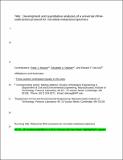| dc.contributor.author | Stewart, Frank J. | |
| dc.contributor.author | Ottesen, Elizabeth | |
| dc.contributor.author | DeLong, Edward | |
| dc.date.accessioned | 2012-03-26T19:05:49Z | |
| dc.date.available | 2012-03-26T19:05:49Z | |
| dc.date.issued | 2010-03 | |
| dc.date.submitted | 2010-01 | |
| dc.identifier.issn | 1751-7362 | |
| dc.identifier.issn | 1751-7370 | |
| dc.identifier.uri | http://hdl.handle.net/1721.1/69861 | |
| dc.description.abstract | Metatranscriptomes generated by pyrosequencing hold significant potential for describing functional processes in complex microbial communities. Meeting this potential requires protocols that maximize mRNA recovery by reducing the relative abundance of ribosomal RNA, as well as systematic comparisons to identify methodological artifacts and test for reproducibility across data sets. Here, we implement a protocol for subtractive hybridization of bacterial rRNA (16S and 23S) that uses sample-specific probes and is applicable across diverse environmental samples. To test this method, rRNA-subtracted and unsubtracted transcriptomes were sequenced (454 FLX technology) from bacterioplankton communities at two depths in the oligotrophic open ocean, yielding 10 data sets representing ~350 Mbp. Subtractive hybridization reduced bacterial rRNA transcript abundance by 40–58%, increasing recovery of non-rRNA sequences up to fourfold (from 12% to 20% of total sequences to 40–49%). In testing this method, we established criteria for detecting sequences replicated artificially via pyrosequencing errors and identified such replicates as a significant component (6–39%) of total pyrosequencing reads. Following replicate removal, statistical comparisons of reference genes (identified via BLASTX to NCBI-nr) between technical replicates and between rRNA-subtracted and unsubtracted samples showed low levels of differential transcript abundance (<0.2% of reference genes). However, gene overlap between data sets was remarkably low, with no two data sets (including duplicate runs from the same pyrosequencing library template) sharing greater than 17% of unique reference genes. These results indicate that pyrosequencing captures a small subset of total mRNA diversity and underscores the importance of reliable rRNA subtraction procedures to enhance sequencing coverage across the functional transcript pool. | en_US |
| dc.description.sponsorship | Agouron Institute | en_US |
| dc.description.sponsorship | Gordon and Betty Moore Foundation | en_US |
| dc.description.sponsorship | United States. Dept. of Energy. Office of Science | en_US |
| dc.description.sponsorship | National Science Foundation (U.S.) (NSF Science and Technology Center Award EF0424599) | en_US |
| dc.language.iso | en_US | |
| dc.publisher | Nature Publishing Group | en_US |
| dc.relation.isversionof | http://dx.doi.org/10.1038/ismej.2010.18 | en_US |
| dc.rights | Creative Commons Attribution-Noncommercial-Share Alike 3.0 | en_US |
| dc.rights.uri | http://creativecommons.org/licenses/by-nc-sa/3.0/ | en_US |
| dc.source | DeLong via Anne Graham | en_US |
| dc.title | Development and quantitative analyses of a universal rRNA-subtraction protocol for microbial metatranscriptomics | en_US |
| dc.type | Article | en_US |
| dc.identifier.citation | Koizumi, Yuichiro et al. “Effects of Solute and Vacancy Segregation on Antiphase Boundary Migration in Stoichiometric and Al-rich Fe3Al: A Phase-field Simulation Study.” Intermetallics 18.7 (2010): 1297–1302. | en_US |
| dc.contributor.department | Massachusetts Institute of Technology. Department of Civil and Environmental Engineering | en_US |
| dc.contributor.approver | DeLong, Edward | |
| dc.contributor.mitauthor | Stewart, Frank J. | |
| dc.contributor.mitauthor | DeLong, Edward | |
| dc.contributor.mitauthor | Ottesen, Elizabeth | |
| dc.relation.journal | ISME Journal | en_US |
| dc.eprint.version | Author's final manuscript | en_US |
| dc.type.uri | http://purl.org/eprint/type/JournalArticle | en_US |
| eprint.status | http://purl.org/eprint/status/PeerReviewed | en_US |
| dspace.orderedauthors | Stewart, Frank J; Ottesen, Elizabeth A; DeLong, Edward F | en |
| mit.license | OPEN_ACCESS_POLICY | en_US |
| mit.metadata.status | Complete | |
